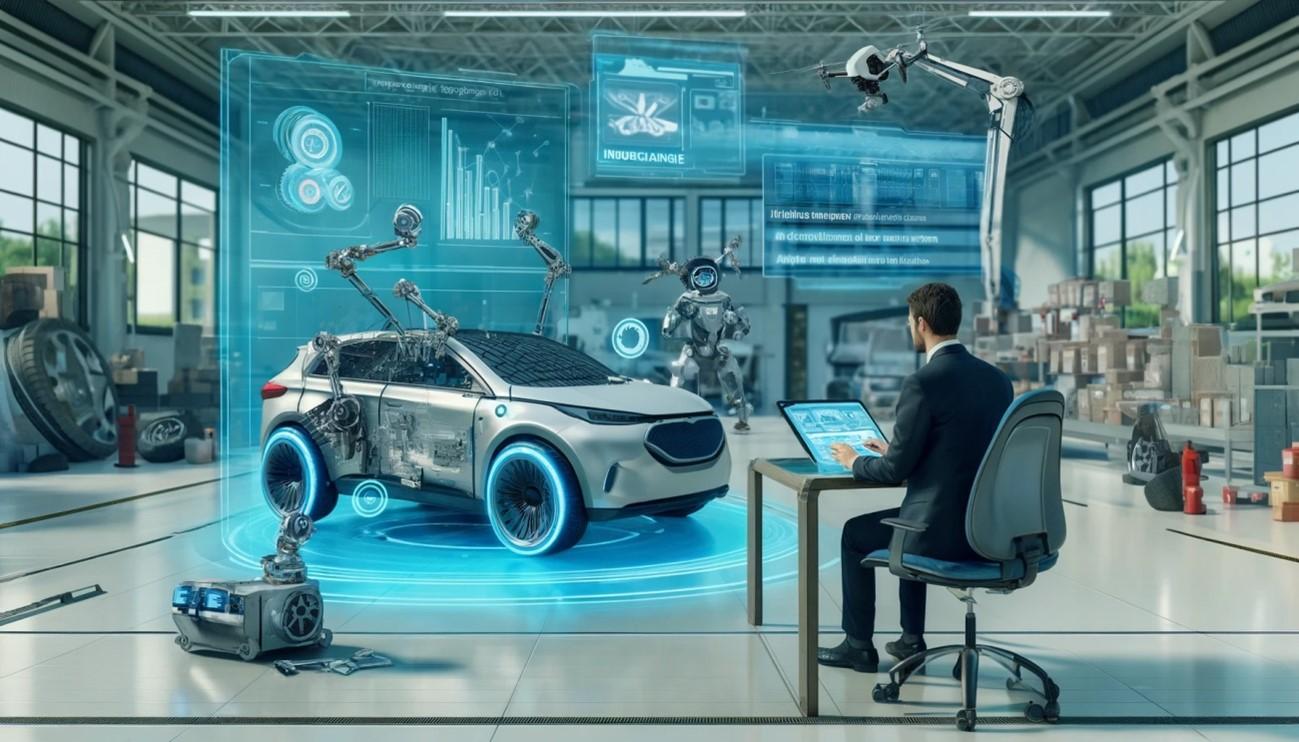Not Everything Fits into an Algorithm
Área de ingeniería
Centro Zaragoza (1)Centro Zaragoza is the vehicle research centre participated by 17 insurance companies, which aims to improve road safety and car reparability.
The field of artificial intelligence (AI) has been in a state of constant flux all through its decades of research and development. Since its inception in the 1950s, when pioneers like Alan Turing and John McCarthy laid the theoretical foundations for artificial intelligence, to its practical implementation today, AI has been on a journey that has redefined multiple facets of our lives.
This has become the guiding principle driving transformation in numerous industries, like the insurance sector, in which AI has emerged as a factor to be reckoned with, redefining how procedures involving loss adjusters can be managed.
Tackling a challenge
In the digital information age society has undergone a significant cultural shift towards immediate responses. Prompted by technology, individuals look for fast answers to their questions and needs. This need for immediate response has transformed the way we interact with the world, from how we consume news and entertainment to how we communicate with others. We are no longer predisposed to wait, and this demand for an instant response is moulding how we live, work, and interrelate.
The demand for speed by the insurance industry in responding is exerting great pressure on companies to adapt and offer faster, more accessible services. Customers expect quick answers to their enquiries, whether they are seeking a quote, filing a claim, or calling for assistance. As a result, insurers are turning to innovative technologies to speed up processes and provide their customers with immediate responses. They are also implementing automation and using artificial intelligence to improve their efficiency and response capabilities to enable insurance companies to satisfy demand in an ever more demanding and competitive marketplace.

Figure 1. Depiction of an automobile being analysed by AI.
Source: AI-generated image.
Assessing damage to vehicles both for losses and for underwriting has long been one of the most important challenges facing insurers. Evaluating the extent and severity of damage to vehicles can be complicated and tedious. It can be slow, subject to mistakes, and prone to bias and is highly dependent on the experience of the human component.
The brains behind the machine
AI, with is ability to analyse large quantities of data, spot patterns, and take decisions based on precise, objective information, holds out the prospect of revolutionising damage assessment. From machine learning algorithms to convolutional neural networks, AI brings a completely new approach to tackling this complex challenge.
Let’s take a look at how AI actually works when assessing damage.
First, it compiles large volumes of visual data in the form of images of damaged vehicles that can be taken from a range of different sources, the most common being pictures taken for companies by loss adjusters and automobile repair shops.
Before AI can analyse the images, the data have to be preprocessed so that they are suitable for input into the AI model. This can include resizing the image, normalising pixel values, and removing image noise or distractors that could affect the precision of the analysis.
After the data have been preprocessed, AI uses machine learning algorithms to extract relevant features from the images. Some of these features might be edge detection, image segmentation, and analysing shapes, outlines, colours, textures, and other relevant visual attributes.
The features extracted are used to train an AI model, which learns to associate specific visual patterns with damage assessment based on data previously labelled by humans, e.g., vehicle damage type and severity.
After the model has been trained, it can be used to assess new images of damaged vehicles. The model analyses the visual features of the images and compares them with the patterns learned during training to estimate the extent and severity of damage.
Neural networks are patterned after the structure of the human brain and enable AI to “see and understand” the visual content of the images, identify damaged areas, estimate the cost of repair, and provide a detailed assessment in real time.
Implementation in the insurance sector
Artificial intelligence can help perform a range of different tasks in the insurance sector. From risk verification to network audits, AI can be a versatile tool fostering efficiency.
Risk verification. When using vehicle images for risk verification at the time of contracting the coverage, AI can play a critical role in taking decisions about insurance covers. Based on the analysis of images and other relevant data, AI can suggest whether to accept or refuse coverage for a given vehicle and can propose potential deductibles or excesses covering existing damage to the vehicle, all in just a few minutes.
Loss adjustment. AI can very quickly analyse images of vehicles, identify areas that have been damaged, assess repair costs, and furnish a detailed breakdown of the action that needs to be taken. This ability can improve claim handling efficiency and for certain types of losses ensure reliable, objective assessment of the damage, and the speed of response raises customer satisfaction.
Triage. AI can use its ability to analyse and classify losses reported to identify claims that require immediate attention and prioritise them based on their severity and urgency. This allows insurers to allocate resources more effectively, automatically adjust technical reserves from first notice of loss (FNOL), and ensure that more critical losses will be handled appropriately, improving the customer experience and enhancing the company’s reputation.
Network audits. Another area in which AI could be helpful is network audits, by analysing large volumes of case files compiled from different repair shops and loss adjusters to identify patterns, trends, and anomalies. This can help insurance companies spot areas that need improvement, detect potential fraud and inappropriate practices, and make informed decisions based on specific data.
Exploring artificial intelligence in the insurance field
Use of artificial intelligence by the insurance industry to assess damage marks a milestone in technological progress by the sector. Through the power of machine learning and advanced data analysis, AI offers transformational potential that can be converted into competitive advantages with a number of benefits. Here are some of the main ones:
- Speed is its greatest virtue. AI can process large volumes of data and carry out complex analyses in next to no time. This makes it possible to respond quickly to customer enquiries and to give priority attention to the most critical cases, thereby enhancing the customer experience by shortening waiting times and making it possible to provide faster service.
- Efficiency is another obvious advantage, stemming from AI’s ability to automate routine tasks and reduce human error, thus optimising resources. By minimising manual processing, AI can increase productivity and precision of the results, enabling resources to be allocated more efficiently.
- Payroll cost and loss adjuster fee savings by automating adjustment and pricing and reducing the number of people involved. The savings obtained by using AI in insurance can help lower insurance companies' combined ratios, lately of such concern in the automobile insurance line.
- The objectivity of the assessments produced demonstrate AI’s ability to provide impartial, data-based assessment uninfluenced by personal prejudice or human bias. This ensures more consistent assessments and decision-making, resulting in fairer and more transparent indemnity proposals and coverage decisions.
- Fraud reduction is another ostensible advantage, since AI can detect patterns and anomalies that could be indicative of fraudulent activities. By analysing and spotting suspicious behaviour, AI can alert insurers to cases of possible fraud, such as bogus or padded claims. This enables insurers to protect the interests of all law-abiding insured parties and translates into more competitive premiums.

Figure 2. Future AI-assisted automobile inspection centre.
Source: AI-generated image.
Artificial intelligence holds out the potential to revolutionise many aspects of the insurance industry, but at the same time implementing it gives rise to challenges and shortcomings that must not be overlooked.
Proper vehicle and parts identification is a critical component of automobile damage assessments and could be a potential drawback to using artificial intelligence. While AI can be quite precise in recognising vehicle models and analysing their component parts, there is a risk that it could make mistakes or misinterpret certain vehicle attributes. For instance, it can be hard for AI to recognise specific vehicle parts and hidden damage not measurable by visual inspection. This could cause inaccuracies when damage is assessed and hence mistakes in allocating repair costs or deciding on the feasibility of repair as opposed to declaring a total loss.
More fraud is another potential risk of using artificial intelligence for these procedures. As technology grows more advanced and widely used in the insurance sector, insurance scammers will try to take advantage of gaps in or the limitations of AI systems to commit more sophisticated, harder-to-detect frauds. For instance, scammers could try to fool AI algorithms by manipulating data or submitting false claims designed specifically to evade automated fraud detection. AI might also miss certain indicators of fraud discernible only to humans. It will be important to achieve a balance between the operational efficiencies that can be obtained using AI and the human oversight needed to ensure effective fraud detection. For that reason, the purported savings in loss adjusters' fees and salary costs mentioned above as a benefit could come with increased claim costs as a downside.
Furthermore, the datasets used to train algorithms could contain inherent bias, e.g., racial, gender, or socioeconomic bias. Failing to address these biases suitably during the AI training process entails the risk that algorithms could reproduce and intensify those biases in its decision-making, which could result in unfair discrimination of certain groups of people.
The absence of human interpretation is a potential risk in situations that require emotional comprehension, subjective judgement, or contextual evaluation extending beyond the objective data. Unlike humans, who can understand the context, intent, and subtleties of a situation, AI systems operate mainly based on patterns and correlations in the data. This means that it can be difficult for them to interpret complex nuance or ambiguous circumstances that require subjective judgement or insight. For example, when assessing vehicle damage, AI may be effective at identifying and quantifying physical damage visible in images but may not be able to consider such contextual factors as vehicle history or the specific circumstances of the accident. This could result in assessments that fail to take into account all relevant aspects of the situation.
This means that while a loss adjuster can not only assess the vehicle damage but also the cost of the repairs proposed by the repair shop, discuss and negotiate the terms of services, and consider additional factors like the quality of workmanship and repair time, AI systems could well lack this capacity for negotiation and ability to adapt to the special circumstances of each case. Vehicle repairs can often require negotiations between the insurer and the repair shop concerning costs, methods of repair, and completion times. The loss adjuster’s experience and negotiating skills are basic to reaching fair agreements satisfactory to both the insurer and the shop and to settling disputes or discrepancies that may arise during repairs. This could lead to agreements unfavourable to one of the parties or to an inability to adapt to the changing needs of the shop or the insured party. Consequently, supervision and involvement by humans will be necessary in complicated cases or in disputes that call for a more flexible and adaptable approach.

Figure 3. Vehicle repairs can require negotiations between the insurer and the repair shop concerning costs, methods of repair, and completion times.
Source: Centro Zaragoza.
Beyond the machine. The human factor
It is essential to stop and think about the ethical implications of this technology when delving into this field. It is true that AI brings a series of benefits, but it also poses challenges that need to be tackled thoughtfully and carefully.
One of the main ethical concerns in relation to artificial intelligence is the issue of empathy and emotional understanding. Philip K. Dick’s novel Do Androids Dream of Electric Sheep?, later adapted to the big screen by Ridley Scott’s Blade Runner, presents the Voight-Kampff test, designed to establish whether an individual is a human or an android. In today’s world we do not have to deal with androids, but the fundamental issue of how AI perceives and responds to human emotions is still relevant.
Let us imagine a scenario in which an insured party has a traffic accident. Can AI, with its ability to analyse data and recognise patterns, truly understand the anxiety felt by the insured? Can it offer the same degree of empathy and support as a human being? These questions force us to think about the intersection between technology and humankind.
Besides the question of empathy, other essential issues in developing and using this technology are transparency and responsibility. AI algorithms can be opaque, making it hard to understand how they arrive at decisions and what data they use to reach them. This raises concerns about fairness and neutrality, especially as regards insurance companies' indemnity proposals.
Data privacy and security are other relevant risks when artificial intelligence is used, especially where confidential and personal data like loss histories, financial details, or location data are used in the corpus employed to train AI models without proper consent by the individuals concerned or where data confidentiality has not been safeguarded. This can lead to concerns about improper use of personal data or the possibility that data will be compromised or stolen by third parties.
Finally, one of the most troubling dilemmas in today’s society is that as this technology grows more advanced and sophisticated, certain tasks and functions traditionally performed by people will be completely automated, and this can produce apprehension about the future role of employees. This job uncertainty can in turn lead to social and economic concerns and a need for job retraining for the employees involved.
A new horizon
“The real danger is not that computers will begin to think like men, but that men will begin to think like computers”. This quote by Sydney Harris warns of the risk that humans will reduce their thinking to simplistic rational and logical processes instead of appreciating the inherent ingenuity, intuitiveness, and complexity of the human mind. Whenever we are interacting with technology and artificial intelligence, we need to be sure not to lose our humanity, our emotional understanding, our critical judgement, and our imagination, basic to our existence and to our growth as individuals.
Abilities like the intuition based on experience, the human capacity to understand context, adaptability to complex situations, and ethical decision-making based on principles and values are hard to quantify and code into algorithms.
It is therefore essential to find a balance between AI and the human involvement needed to tackle the subjective, contextual, and ethical aspects of every situation. Successfully integrating AI into the insurance industry will require amicable cooperation between people and machines so that we can recognise the capabilities and limits of each and in that way take full advantage of the potential of both to drive innovation, improve the customer experience, and ensure fair decision-making.
In a world where technology and humankind come together, artificial intelligence is a powerful tool people can use to work more efficiently.
When all is said and done, not everything fits into an algorithm.
The demand for speed by the insurance industry in responding is exerting great pressure on companies to adapt and offer faster, more accessible services. Customers expect quick answers to their enquiries, whether they are seeking a quote, filing a claim, or calling for assistance. As a result, insurers are turning to innovative technologies to speed up processes and provide their customers with immediate responses. They are also implementing automation and using artificial intelligence to improve their efficiency and response capabilities to enable insurance companies to satisfy demand in an ever more demanding and competitive marketplace.